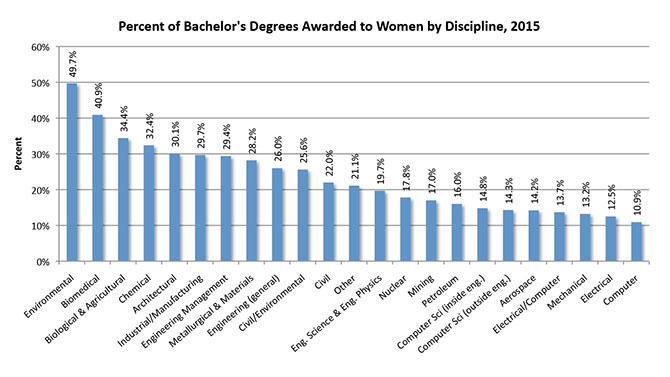At Middle School Pathways to Engineering Day this spring, we hosted an information session for parents, modeled after the Society of Women Engineers Parent Educator Program (PEP). Our goal was to share our experience with studying engineering in college, and to share some thoughts on how to encourage middle school students, particularly girls, to pursue their interest in STEM.
The number of women in engineering has been increasing over the years, but is still quite low. According to SWE research, the percent of engineering bachelor’s degrees awarded to women in 2015 ranged from 10.9% to 49.7% depending on the discipline [1].

Figure credit: Society of Women Engineers [1].
The big question is: why are there so few women in engineering? According to the SWE 2016 literature review, there are a few key reasons. In middle school and high school, women taking math and science classes are more likely to doubt their academic prospects and their ability to pursue STEM studies and careers [1]. Also, engineering is stereotypically a masculine field, and is traditionally dominated by men. So, many young women do not feel like they fit into the field, and as a result, often dismiss engineering as an academic and career option [1]. In addition, women tend to be drawn to fields where they feel they can make a significant societal impact, and therefore do not always feel that engineering reflects their values and career goals [1].
However, though engineering is not traditionally seen as a field that has a large social impact, engineers are vital to helping improve our quality of life and wellbeing! Engineering is a broad field that encompasses a variety of different disciplines like biomedical, chemical, civil, electrical, environmental, and mechanical engineering. These are all extremely interdisciplinary and pull from fields like physics, chemistry, math, biology, computer science, materials science, as well as economics, business, and social science. Design of better medicines and medical devices, developing new sources of energy, improving urban infrastructure, and improving access to clean air and water all fall under the umbrella of engineering.
So, what can we do to encourage young girls to pursue their interest in STEM, despite these negative forces? Exposing students to diverse engineering role models is critical. Meeting role models that they can relate to is critical to making young girls feel that engineering is a realistic academic and career option. Encouraging resilience in students and a growth mindset is also an effective strategy. Emphasizing that challenges and failures do not determine the limits of their abilities but instead help them grow will go a long way in promoting self-confidence. Finally, enrolling students in STEM outreach programs at local universities or museums is a great way to introduce them to life as an engineer, and to introduce them to relatable, diverse role models!
For more information on women in engineering and the SWE 2016 literature review, check out http://alltogether.swe.org/2017/03/women-engineering-review-2016-literature/
[1] Meiksins, P., et al. “Women in Engineering: A Review of the 2016 Literature.” SWE Research 2017, Magazine of the Society of Women Engineers. March 2017.